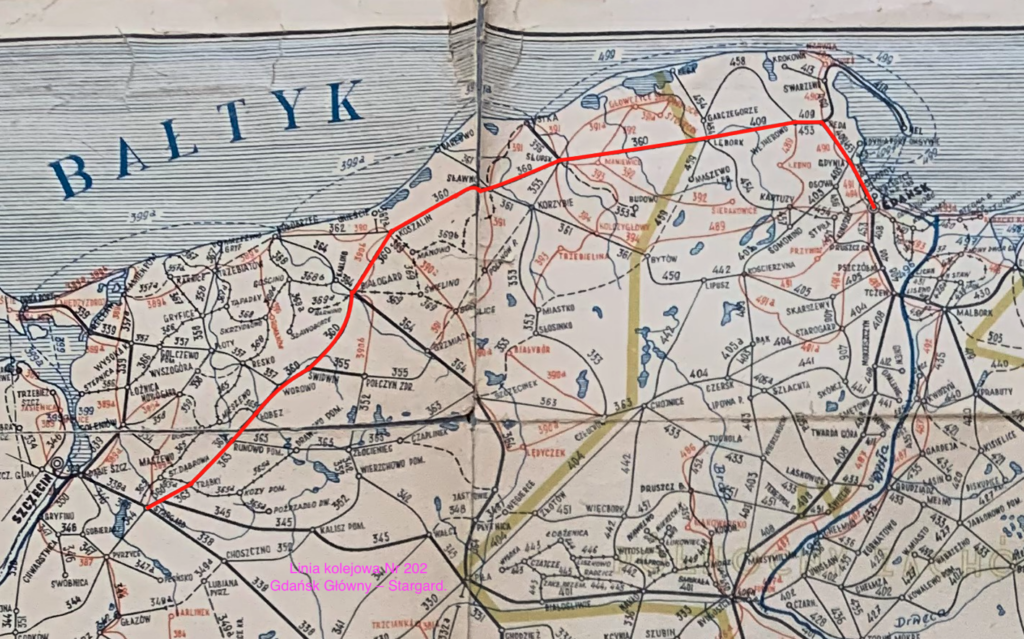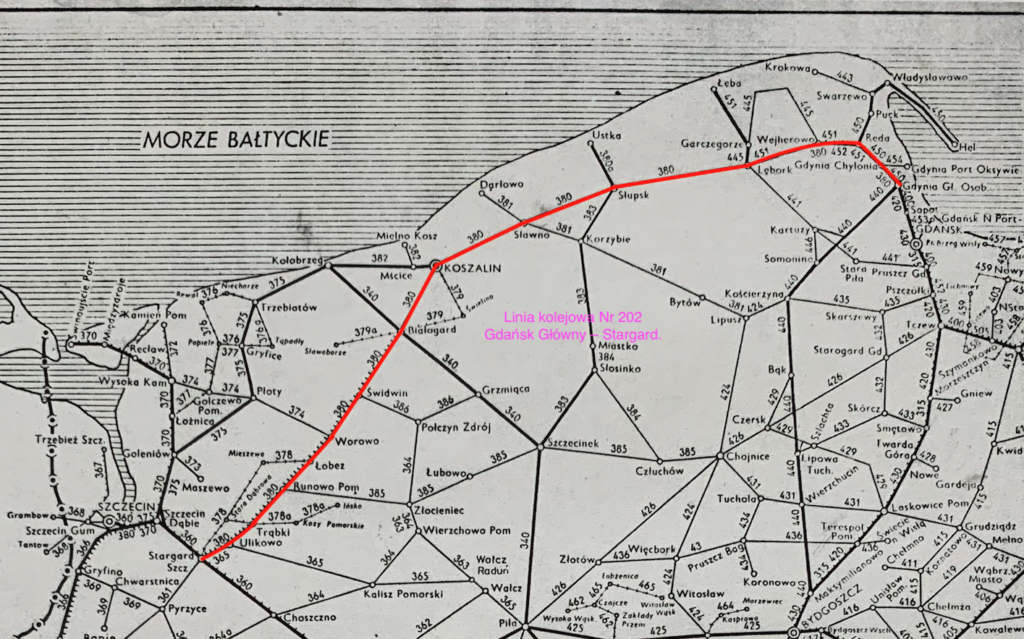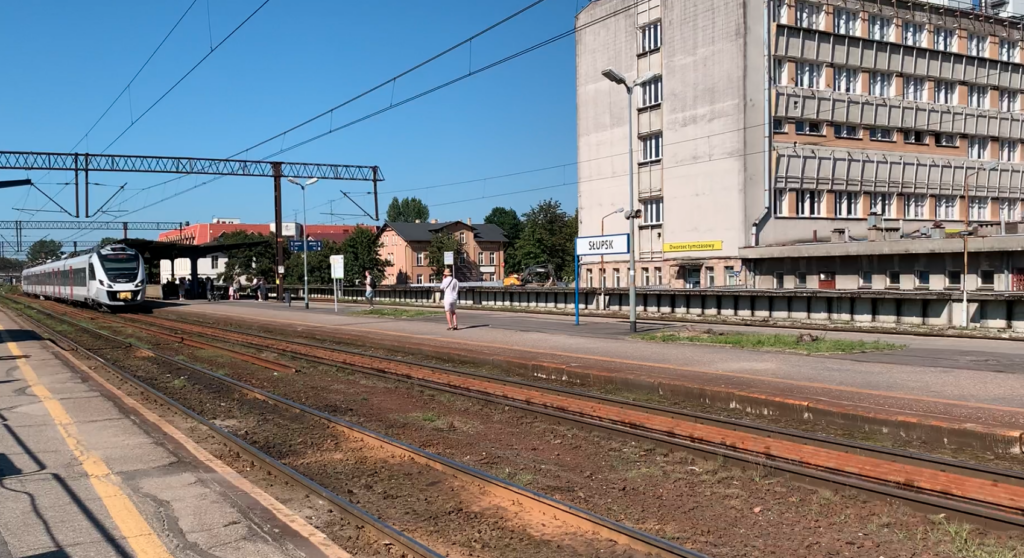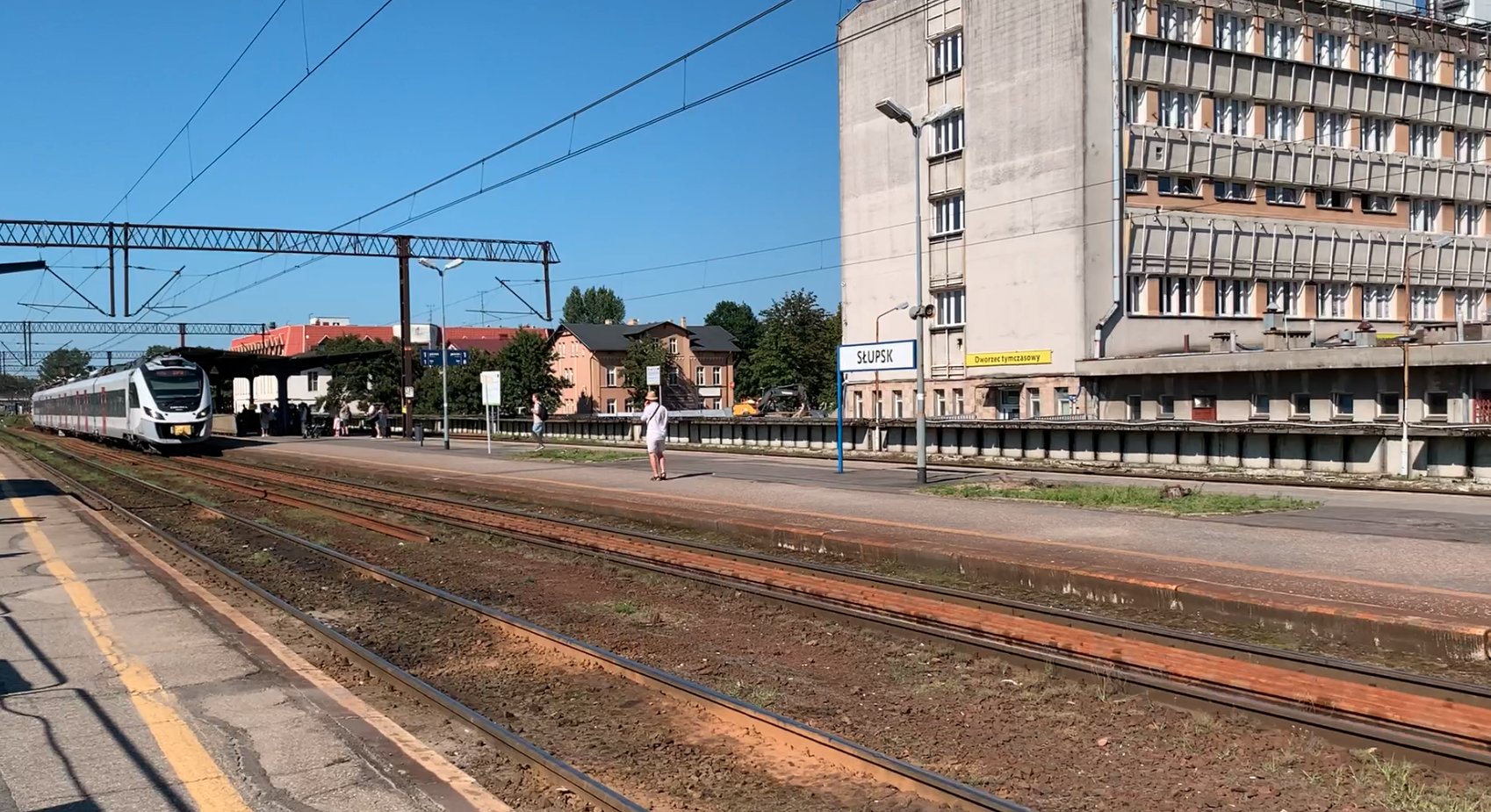Słupsk 2024-08-29
Railway line No. 202 Gdańsk Główny – Stargard.



Railway line No. 202 Gdańsk Główny – Stargard, stretches in the northern part of Poland, in the latitudinal direction and runs through the Pomeranian Voivodeship and the West Pomeranian Voivodeship. LK No. 202 is 334.363 km long. The line is electrified with 3 kV DC current. The maximum speed is 140 km/h. The line is single-track and double-track.
History of LK No. 202.
From the very beginning, the line had a track gauge of 1435 mm. In 1843, the construction of the Berlin-Szczecin railway line was completed. It was the first railway line in Pomerania, which at that time belonged to the Germans. The lines were built by the Berlin-Szczecin Railway Company (Berlin-Stettiner Eisenbahn-Gesellschaft – BSE). In 1846, another section was built, Szczecin – Stargard. Around 1855, the BSE subsidiary, the TylnoPomorska Kolej Żelazna (Hinterpommersche Eisenbahn), received a concession to build a line further east. On June 1, 1859, the line was extended to Koszalin (BStE), and Stargard station became a junction station. On July 1, 1869, the Koszalin – Słupsk section was opened. On September 1, 1870, the Słupsk–Gdańsk Główny (BStE) section was opened.
The line was designed as a double-track line from the very beginning. In 1902, a second track was laid on the Runowo Pomorskie–Stargard section. Around 1909, on the Lębork–Słupsk section. Also around 1909, a second track was laid on the Białogard–Runowo Pomorskie section. After World War II, a second track was laid; in 1953, Runowo Pomorskie–Chociwel (PKP) and in 1955, Chociwel–Ulikowo (PKP).
Electrification: On September 13, 1969, Gdańsk Główny–Gdynia Główna (PKP). On the SKM line, on December 30, 1957, Rumia–Wejherowo (PKP–SKM 800 V DC). On October 19, 1969, Rumia – Wejherowo (PKP, 3 kV DC) On September 6, 1989, Wejherowo – Słupsk. On December 2, 1988, Koszalin – Słupsk. On June 30, 1988, Białogard – Koszalin. On December 15, 1987, Świdwin – Białogard. On July 15, 1987, Runowo Pomorskie – Świdwin. On December 16, 1986, Stargard – Runowo Pomorskie.
In 1914, the Germans started the Great World War. As a result, in 1920, the line found itself within the borders of three countries: the Weimar Republic (Germans), the Second Polish Republic and the Free City of Gdańsk. Border stations had to be built on the line. On the Germanic side, it was the Groß Boschpol (Bożepole Wielkie) station. On the Polish side, the border station was the Strzebielino station. Before Gdańsk, the Polish station was the Kolibki Orłowo station (now Gdynia Orłowo). The provisions of the Treaty of Versailles stated that in Gdańsk the railway was to be operated by PKP, but the official language was to be Germanic. Therefore, the name of the station was written only “Danzig”. And again, in 1939, the Germans started another world war. As a result, the Germans lost many territories, including the entire Pomeranian Voivodeship. As a result, the entire railway line found itself within the borders of Poland. In 1945, Soviet “trophy” units liquidated the second tracks on the section; Runowo Pomorskie – Białogard, Słupsk – Lębork, Gdynia Główna – Lębork, Runowo Pomorskie – Ulikowo. The dismantled tracks, switches and railway traffic control devices were taken to Moscow.
In the period 1952-1956, a parallel line to LK No. 202 was built on the Gdańsk Główny – Gdynia Chylonia section. Currently, this line has No. 250. This line is double-track and was built for the Tri-City SKM. In 1985, the line was extended to Rumia and several new passenger stops were built.
On LK No. 202, in 1971, the speed of passenger trains was increased from 90 km/h to 100 km/h. In 2024, the maximum speed of 100 km/h was in force on most of LK No. 202 for passenger trains. Although there were four short sections with a maximum speed of 140 km/h and several with a speed of 120 km/h. On the Gdańsk Główny – Lębork section, freight trains have a permissible speed of 100 km/h, and on the remaining route up to 80 km/h. At stations, the speed is limited, mainly by the installed English-type switches.
Currently, 2024, four passenger trains cover the entire LK No. 202. First; InterCity “Rybak” IC 18104, in 4 hours 28 minutes, ticket price PLN 71. Second; InterCity “Gryf” IC58106, in 4 hours 29 minutes, ticket price PLN 71. Third; InterCity “Stańczyk” IC58108, in 4 hours 6 minutes, ticket price PLN 71. Fourth; InterCity “Albatros” 58100, in 4 hours 24 minutes, ticket price PLN 71. The heaviest passenger traffic is on the Gdańsk – Słupsk section. There are 16 pairs of trains running on the route daily. Among them are 2 EIP “Pendolino” trains, with a travel time of 1 hour 33 minutes, and the ticket price is PLN 117. InterCity trains cover the route in 1 hour 38 minutes to 2 hours 8 minutes, and the ticket price is PLN 41. PolRegio trains cover the route in 2 hours 5 minutes to 2 hours 36 minutes, and the ticket price is PLN 28.30. In addition, there are several options for travel with transfers on the Gdańsk–Słupsk section.
There are 20 pairs of trains on the Słupsk–Stargard route. InterCity trains cover the route in 2 hours 13 minutes to 2 hours 24 minutes, and the ticket price is PLN 58. PolRegio trains cover the route in 2 hours 43 minutes to 3 hours 4 minutes, and the ticket price is PLN 43.60.
Modernization of LK No. 202.
In the period 2012-2014, the line on the Gdańsk Główny – Gdynia Chylonia section was modernized. At that time, the second track was reconstructed and some turnouts were rebuilt. SRK devices were replaced.
The modernization of the Gdynia Chylonia – Słupsk section is planned. On this section, the construction of a second track, optimization of the route and construction of new passenger stops will be carried out. It is planned to increase the speed of passenger trains to 160 km/h, and freight trains to 120 km/h. On 19 January 2018, an agreement was signed for the project of modernization of the Gdynia – Słupsk section. The value of the project is PLN 30 million. The Wejherowo – Lębork – Słupsk section is to be adapted to the speed of 200 km/h, for long-distance trains. As part of the works, more tracks No. 3 and 4 for SKM traffic are to be built, on the Rumia – Wejherowo section. As part of the planned investment, the construction of seven new stops is planned: Reda Buczka (Gniewkowska), Bolszewo, Gościcino Zielony Dwór, Łebień, Siemianice, Runowo and Łebień. The reconstruction of 22 stations and stops is planned. In addition, 18 new underpasses with lifts will be built, and 7 will be modernized. Among others, in Słupsk, Potęgowo and Damnica. As part of the investment, 47 bridges, viaducts and culverts will be modernized. Local Control Centers are to be built. On the entire route, the travel time is to be shortened by 30 minutes, with a greater number of stops. It is planned to increase the speed of passenger trains to 160 km/h, and freight trains to 120 km/h. The design work was completed in 2020, and construction work was planned for the period 2021-2025. The task was divided into several stages and there was a separate tender for each of them. The renovation on the Gdańsk-Słupsk section is worth PLN 1.8 billion. After the “December 13 coalition” comes to power, the modernization may not be carried out.
Route of LK No. 202:
The line runs from east to west, generally through sparsely urbanized areas, wastelands and forests. Gdańsk Główny 0.00 km, elevation 4 m, station. The line runs under the viaduct DW No. 468. Gdańsk Wrzeszcz, 4.18 km, elevation 6 m, station. Gdańsk Zaspa 5.39 km, elevation 8 m, station. Gdańsk Oliwa 8.08 km, elevation 11 m, passenger stop. Sopot Wyścigi, 10.18 km, elevation 14 m, former station. Sopot 11.66 km, elevation 16 m, station. The line runs under the viaduct DW No. 468. Sopot Kamienny Potok 13.55 km, elevation 22 m, former passenger stop. Former border of the Free City of Gdańsk – Poland (1920-1939). Gdynia Orłowo 15.89 km, elevation 30 m, station. Our station is a footbridge. Gdynia Główna 20.99 km,, elevation 15 m, station. The tracks run at Platform No. 4 and 5. There is an LCS here. The line passes the Gdynia Leszczynki passenger stop and the Gdynia Postojowa freight station. Gdynia Chylonia 26.17 m, elevation 26 m, station. The line passes the Gdynia Cisowa Postojowa SKM freight station. The line continues along DW No. 468, which runs over the tracks on a viaduct. Rumia 31.84 km, elevation 20 m, station. From this point, the double-track line No. 202 is not accompanied by other tracks. Reda 35.43 km, elevation 20 m, station. Here LK No. 213 branches off from LK No. 202. Now LK No. 202 changes direction to the west, and on the south side green areas begin. Reda Pieleszewo 38.20 km, elevation 29 m, passenger stop.
The town of Wejcherowo begins. Wejherowo Śmiechowo 41.04 km, elevation 31 m, passenger stop. Wejherowo Nanice 42.89 km, elevation 22 m, passenger stop. The line crosses the Cedron River. Wejherowo 43.99 km, elevation 28 m, station. Rolling stock repair plant. Line No. 202 begins as a single-track line. Gościcino Wejherowskie 48.60 km, elevation 49 m, passenger stop, passing loop. The line crosses the Gościcina River and then the Bolszewka River. The line runs in the Bolszewka River valley. Luzino 54.56 km, elevation 79 m, station. The line enters forest areas. On the northern side runs the S6 Expressway. The line runs under DW No. 468. Strzebielino Morskie 59.41 km, elevation 56 m, station. Former Poland-Germany border 61.00 km. The line crosses the Łeba river. Bożepole Wielkie 63.65 km, elevation 47 m, station. The DW No. 468 viaduct runs above the line (Lęborska street). Godętowo 70.50 km, elevation 29 m, station. Lębork Mosty 76.44 km, elevation 30 m, passenger stop. The line crosses the Okolnica river. The line crosses the rail-road intersection with DW No. 214. Lębork 79.74 km, elevation 24 m, junction station (LK No. 229, 237). Leśnice 85.65 km, elevation 20 m, passenger stop, former station. Pogorzelice 87.81 km, elevation 24, station. The line crosses the Pogorzelica river. A line correction is designed here to straighten it. Runowo, passenger stop. Potęgowo 98.46 km, elevation 86 m, station. Głuszyno Pomorskie 103.00 km, elevation 78 m, passenger stop. Strzyżyno Słupskie 105.99 km, elevation 75 m, passenger stop. The line passes the Łupawa river. Łebień, passenger stop. Damnica 112.65, km, elevation 63 m, station. Jezierzyce Słupskie 122.25 km, elevation 70 m, station. There were sidings to local plants: BałtykGaz and Getreide AG, but they are now closed. Siemianice, passenger stop.
The city of Słupsk begins. The line runs under DW No. 213. The line crosses the Słupia River. Słupsk 131.17 km, elevation 24, junction station (LK No. 405). The line passes under the DK No. 21 viaduct. The line runs under the S6 Expressway viaduct. Reblino 139.58 km, elevation 49 m, passenger stop, passing loop. Rail-road intersection with DK No. 6. Sycewice 144.37 km, elevation 51 m, passenger stop. Voivodeship border 145 km. Wrześnica 149.05 km, elevation 38 m, passenger stop, passing loop. The line crosses the Wieprza River and then the City Canal. Sławno 158.23 km, elevation 26 m, large junction station (LK No. 418 Darłowo), the station has three platforms. Rail-road intersection with DK No. 37. Karwice 167.21 km, elevation 33, station. The line crosses the Grabowa River. Wiekowo 178.31 km, elevation 11 m, passenger stop, passing place. Skibno 186.60 km, elevation 33 m, station. The line crosses the Polanica and Uniesta rivers. The line crosses DW No. 203 viaduct. The line runs under the viaducts of the S6 Expressway. The city of Koszalin begins. From Koszalin, the line heads southwest. Koszalin Wschodni 195.58 km, elevation 34 m, passenger stop. The line passes under the viaducts of DW No. 167. Koszalin Politechnika 196.76 km, elevation 29 m, passenger stop. Koszalin 198.30 km, elevation 37 m, large junction station (LK No. 402). Nearby is the Narrow Gauge Railway station; Koszalin Narrow Gauge. Niekłonice 202.86 km, elevation 40 m, passenger stop. The line runs under the viaducts of the S11 Expressway. Dunowo 207.81 km, elevation 27 m, passenger stop. The line crosses the Radew River. Nosówko 212.00 km, elevation 26 m, station. Kościernica 217.23 km, elevation 22 m, passenger stop.
The city of Białogard begins. Białogard 222.63 km, elevation 25 m, junction station (LK No. 404), the station has three platforms. The Koszalin Commuter Railway was here; Białogard Miasto – Świelino, LK No. 8015. The line crosses the Parsęta river. Czarnowęsy Pomorskie 230.52 km, elevation 50 m, passenger stop, passing place. Rąbino 239.05 km, elevation 74 m, station. The line crosses the Rega river. The line passes DW No. 162 at a rail-road intersection. Świdwin 255.10 km, elevation 89 m, station. Formerly LK No. 421 junction station. The line crosses DW No. 152 at a rail-road intersection. Świdwin Zamek 256.39 km, elevation 86 m, passenger stop. Rail-road intersection with DW No. 151. Klępnica 266.00 km, elevation 77 m, passenger stop. The line crosses the Rega River. Worowo 269.67 km, elevation 74 m, station (former junction station, LK No. 420 Worowo – Wysoka Kamieńska). The line crosses the Łoźnica River. Łobez 276.70 km, elevation 65 m, station. The line crosses the rail-road intersection DW No. 151. Lesięcin 284.31 km, elevation 66 m, passenger stop. The line crosses the Reska Węgorza River. A double-track route begins before the bridge.
Runowo Pomorskie 288.71 km, elevation 85 m, junction station (LK No. 210). Cieszyno Łobeskie 294.42 km, elevation 99 m, passenger stop. Chociwel 305.88 km, elevation 80 m, station. Railway-road intersection with DW No. 144. Railway-road intersection with DK No. 20. Lisowo 310.93 km, elevation 85 m, passenger stop. The line crosses the Krępa river. Trąbki 316.65 km, elevation 65 m, station. Former narrow-gauge railway station LK No. 8002 Stara Dąbrowa – Drawsko Pomorskie Wąskotorowe. The line crosses the Krepiel river. Gogolewo 321.47 km, elevation 52 m, passenger stop. Ulikowo 326.24 km, elevation 49 m, junction station (LK No. 403). The line crosses DR No. 20 at the top. The line crosses the Ina River and reaches Stargard station from the south. Stargard (previously Stargard Szczeciński) 333.66 km, elevation 34 m, junction station (LK No. 351, 411).
Written by Karol Placha Hetman

Leave a Reply
You must be logged in to post a comment.